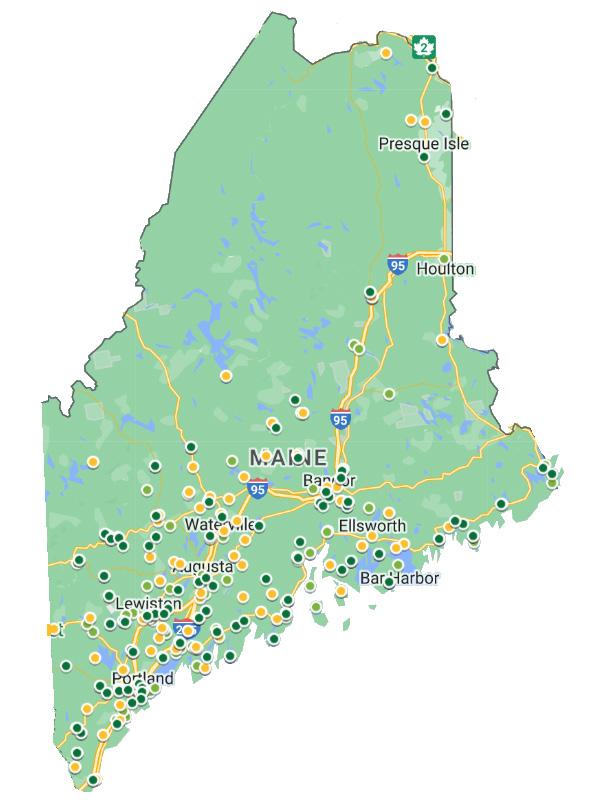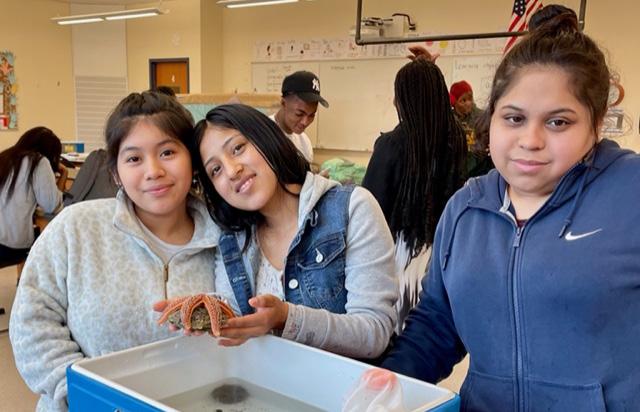Mini-Grants for Outdoor Learning
2022-2023
Over the course of the 2022-2023 school year, MEEA received $153K from donors to distribute to over 100 schools in all 16 counties to advance outdoor learning efforts.
By funding teachers invested in outdoor learning across the state, we’ve reached over 70,000 students in the past three years. Some of the outdoor learning projects this year include planting raised beds, collecting outdoor samples and observing specimen, building outdoor learning spaces, and purchasing foul-weather gear.
In this report, we share snapshots of the 105 mini-grant funded projects across schools in Maine.
Snowshoes, 4
Science Exploration, 15
Outdoor Recreation, 18
Outdoor Classroom Solutions, 16
$153,083 distributed to schools
Art Outdoors, 2
Curriculum & Professional Development, 3
Field Trip, 6
Foul Weather Gear, 8
Garden & Greenhouse, 19
*Number of projects in each category
Projects funded in all 16 counties >30,000 youth impacted 105 applications funded

Highlighted Projects
CHELSEA ELEMENTARY SCHOOL
KATAHDIN ELEMENTARY SCHOOL
Students in our Life Skills classroom worked together to build our wheelchair accessible elevated garden beds. They were skeptical at first about their ability to complete the project, because for most of them it was their first time using power tools. They learned about tool safety and soon became friends with “Mr. Drill” as one of our students put it. They developed a twotier design so they could grow plants that require more depth for roots as well as plants with shallower root systems: a true innovation. They did such an incredible job building the elevated beds that when we displayed their work during our Plant and Seedling Sale and end-of-year Celebration of Learning, many families and community members asked if the beds were for sale! “Team work makes the dream work,” as one student said, and that’s certainly true in our Life Skills classroom. We wrapped up the school year by planting the seedlings they had started in our elevated garden beds. They chose to plant tomatoes, peppers, marigolds, thyme, basil, lemon balm, and nasturtium. We’re all looking forward to our harvest at the end of the summer.

The Katahdin Elementary School playground in Stacyville, ME magically transforms into a winter wonderland from the months of December through early April. As the snow accumulates, so does children’s excitement as they watch the snowbanks around the school grow to great heights. Some ascend as high as 10 feet or more at winter’s peak. Stacyville averages 90 inches of snow per year, and each snowstorm brings new fun and play opportunities. Children who attend KES know that they will be spending at least an hour or more a day outside learning, playing or exploring.
We are thankful for the funds we received from MEEA to help us add to children’s fun and creativity in the snowy months. The funding provided us the opportunity to put more snowgear equipment in the hands of children. With our funds, we purchased new, quality snow sleds and shovels for students to use at recess. This funding served over 130 students at Katahdin Elementary School. At recess, children could be seen climbing up and down the giant snowbanks, positioning sleds, and waiting for friends to hop in and join the fun. Children could also be seen towing one another across the playground as sounds of laughter filled the air.
Cathy Duffy, who teaches Pre-K said, “The children love sliding on the big banks of snow with their new sleds, making snow forts with the new shovels and exploring!” Beth Somers, who also works in PK, said this about the new sleds, “We read Ten On the Sled today, then we got the chance to head outside to try our own Ten On a Sled. We didn’t quite get 10, but they sure had fun trying!” The sleds purchased through MEEA funds were used at recess, and also connected to the curriculum and read alouds unfolding in the classroom.
It is wonderful to see how simple toys such as sleds and shovels can be used in multiple ways. Through the winter, children could be seen playing, creating, communicating, and collaborating as they used the new gear.

2 Maine Environmental Education Association Mini-Grants for Outdoor Learning
Rosanna Gargiulo
Brittany Arbo
MEDOMAK VALLEY HIGH SCHOOL Anna
Myers
Students in the Medomak Alternative Program at Medomak Valley High School did a months-long project on water quality. They were presented with a fictional scenario in which a new industry was proposing to build a factory by a river in our district. Students acted as town officials tasked with deciding if the factory would be allowed to come. The factory would bring jobs and provide resources (students expressed that they’d really like physical improvements to their school!), but since the economy also depends on natural resources, would it be worth it if water quality suffered?
Throughout the colder months, students did experiments and activities around watersheds, eutrophication, pH, and dissolved oxygen. In the spring, they went on field trips to test these parameters and study biodiversity in nearby streams, ponds, and lakes, drawing conclusions about local water quality. In the end, they concluded that water in the areas we tested is healthy. They also decided that the (fictional) factory could come, but there was a very long list of rules and regulations it would have to follow.
The connection to our own community made this an engaging project. It allowed the students to immerse themselves (sometimes quite literally, as shown by the photos) in the content. Having materials such as stream tables and dissolved oxygen kits allowed us to connect with the environment when it was difficult to get outside. In the warmer weather, students were excited about collecting freshwater organisms and identifying them with microscopes. A highlight was discovering that dragonflies look very different in early spring!

We are deeply grateful to the Maine Environmental Education Association for making this meaningful work possible. Thank you!
PORTLAND HIGH SCHOOL
Kirsten McWilliams
The funds given by MEAA were used to fund the transportation, food, gear, and fees for numerous trips. We were able to travel outside of Portland and far into the Northern Maine woods because of the funds that went towards paying for gas. On long day trips and overnights, we had money to spend on food to supply students with snacks and meals. We were also able to pay many fees for students who could not afford it. On a day trip to Evo Rock Gym, we could pay for 18 students’ entrance fees to climb. We paid for 8 students to stay overnight at Stratton Brook with Maine Huts and Trails. Finally, we could get a bus for transportation up to Kingfield Maine on a Bigelow volunteering trip with the Maine Appalachian Trail Club to volunteer in trail maintenance.
Without these funds, we would not have been able to give students so many free or opportunities and fun adventures with outside organizations. The impact of these trips is huge for both Native Mainers and New Mainers being able to meet and befriend each other in places of nature and in times of service. The funds allowed us to create community in our school, giving entrance into the beauty and fun of the outdoors, which is hugely therapeutic in times of trauma here in the US with the pandemic and current politics, as well as abroad. So much bonding and healing occurred on these trips.

3
Highlighted Projects
Three Years at a Glance
Over the past three years, MEEA’s Mini-Grants for Outdoor Learning Program has impacted students and teachers all over the state. The program reaches all 16 counties and supports a wide variety of projects and types of outdoor learning. Through this program, 369 applications have been funded, for a total of $483,651.11 of funds going directly to teachers. Our review process continues to use the most up-to-date % Free and Reduced Lunch Eligibility to determine which schools demonstrate the highest levels of socio-economic need. We also have a rigorous blind double scoring review process using a standardized rubric. We are very excited about the data information systems we have built and continuously improved to support this robust and complex grant program in the last three years. We have continued our commitment to a simple application process to reduce barriers for educators who for most this is their first grant they have ever written. During this third cycle, we also inquired about the projected number of students the project would reach.
Below we’ve included a breakdown of fund distribution (by county, percent need, and cycle) and number of youth impacted each cycle. We appreciate your support as this program continues to support teachers and students across the state. We’re seeing fantastic results and can’t wait to see where this year’s recipients do!
With gratitude,
The Maine Environmental Education Association
3-YEAR CUMULATIVE STATISTICS
Over the past three years, this funding has supported 369 applications and 308 unique teachers. This includes 233 different schools over the course of three years. We’ve directed close to $500,000 to these schools. We’ve achieved a robust geographic spread in all three years through both direct outreaches to schools and the notoriety of the program, ensuring that we funded applications in all 16 counties.
YOUTH IMPACT
By funding teachers invested in outdoor learning across the state, we’ve reached over 70,000 students. In grant cycles 20212022 and 2022-2023, we collected data during applications by asking applicants how many students they expected the impacts of this project would reach. We did not collect such data during our first cycle (2020-2021), so impact numbers are an estimate based on school, and classroom data.
In our first cycle, we reached over 13,000 students, and doubled that number to over 27,000 by the following year (20212022). Last cycle (2022-2023), we again welcomed an increase in reach at 30,000 youth.
$483,651 distributed to schools
233 schools funded in all 16 counties
>70,000 youth impacted 369 applications funded
4
Three Years at a Glance
GEOGRAPHIC SPREAD
In every grant cycle, we’ve been able to fund applications from every county. Notably, we have seen an upward trend in the number of applications from Aroostook, Lincoln, and Washington, with a declining trend in the number of applications being funded in Cumberland county. We are witnessing this trend because of intentional outreach and network building in rural, under-resourced counties and, with limited funding and an increasing number of applications outside of Southern Maine, we are funding less in Cumberland county. We continue to prioritize highest needs schools in all counties.



PERCENT NEED
(i.e. Percent Eligible for Free & Reduced Lunch)
Each year, we determine this value using the most up-todate data from the Department of Education (Department of Education, Nutrition Reports, Maine DOE, 2021 and 2022). These values determine which applications we prioritize during the review process.
Four schools schools who applied, receiving $5,700 in total, do not report such data and are not included in the graph.
5
Graph 2: Number of applications and total funding allocated by percent need category (assessed using most recent data from DOE).
Graph 1 (left): Funding allocated over three years to each county. Map 1 (above): Map of Maine depicting the geographic spread of funded projects
Help Support This Program!
According to the Maine Environmental Literacy Plan, which MEEA was an integral partner in writing with the Maine Department of Education, learning outside improves students’ academic performance, advances critical thinking skills and supports their personal growth, confidence, autonomy, and leadership skills. Taking class outside also improves students’ overall health and wellbeing, like decreasing stress and anger, improving physical health and relationship skills.



We are excited to continue this vital support for teachers in the 2023-24 school year and would encourage anyone interested in applying for next year’s support or donating to this program to reach out to us at anna@meeassociation.org. If you or your organization are interested in donating to this fund, please contact grants@meeassociation.org!

6 Maine Environmental Education Association Mini-Grants for Outdoor Learning












